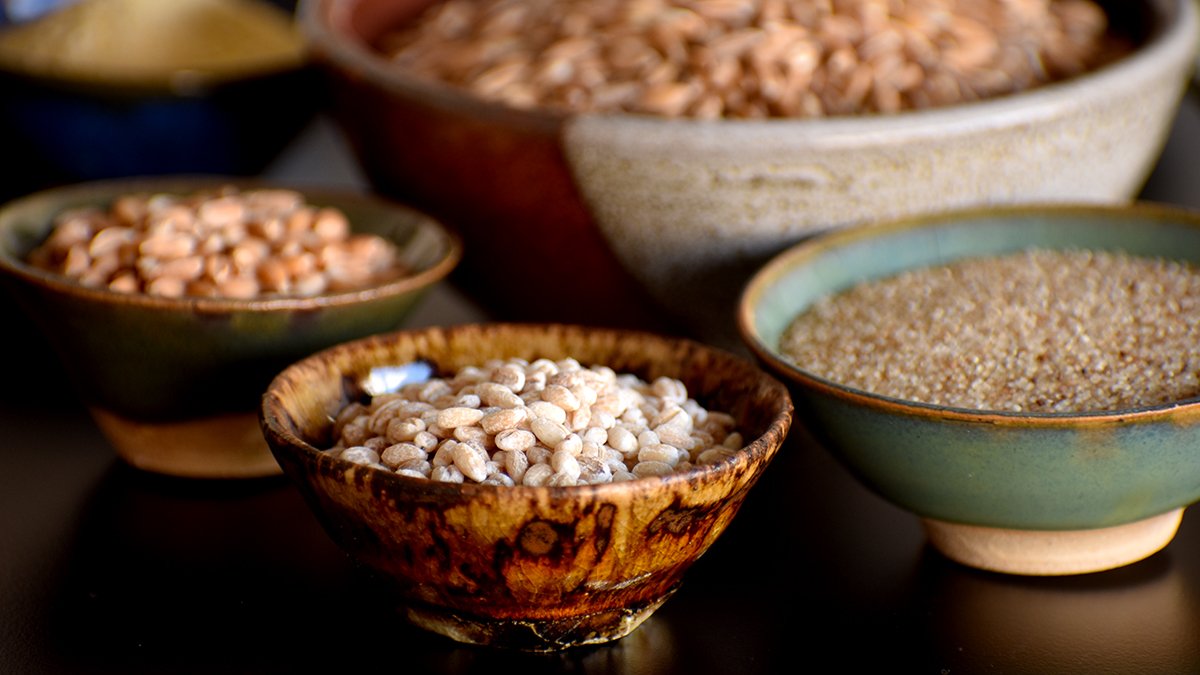What are Intact Whole Grains?
By the Gracious Vegan
Some nutritional experts take pains to differentiate “whole grains” from “intact whole grains.” This distinction has to do with the degree of processing that the grains have gone through.
What does “intact whole grain” mean?
Most of us know that grain kernels naturally contain bran, germ, and endosperm layers. When all three layers are present, we call the resulting product a “whole grain.” When the bran and germ layers are removed, leaving only the endosperm, we call the products “refined grains.” Hence white rice and white flour are refined grains made up solely of the starchy endosperm.
The “whole grain” category includes whole wheat flour, oats of all kinds, farro, millet, barley, and many more. But not all whole grain foods are in the same form when we eat them. To make whole wheat flour, for example, producers crush and grind the grains. That is, the grain kernel is no longer “intact.” Compare this to a wheat berry – it’s the original kernel, uncrushed and unground.
Are intact grains the healthiest grains?
Intact grains like wheat berries feed our gut bacteria better than more processed whole grains, because our digestive systems don’t break them down as easily as ground, rolled, or crushed grains. Even if we chew our food well, we can’t break down the entire kernel structure in our mouths, and some of those larger bits of kernel, with their connected nutrients, can make it all the way down to our colon, bringing precious fiber and micronutrients to our good gut bacteria. Those bacteria, in turn, produce an array of post-biotics that boost our immune system and countless other parts of our bodies.
Intact grains also have a lower glycemic index than more crushed and ground whole grains, meaning they don’t spike our blood sugar when they’re eaten. In fact, they tend to promote a steady energy level that can keep us on an even keel for hours.
What are the most common intact grains?
Look for grains where you can see the kernel. These are intact whole grains.
Oat groats
Rye groats (also known as rye berries)
Wheat berries—white and red—and their relatives Einkorn, spelt, whole farro, and Khorasan
Hulled barley (also called dehulled barley)
Sorghum (gluten-free)
Millet (gluten-free)
Brown, black, and red rice * (gluten-free)
* Some experts suggest caution about brown rice consumption because of arsenic levels. (See also this Consumers Reports article and this excellent summary of arsenic-related issues.) See Lundberg’s page on the arsenic levels in their rice—the levels are low.
Many grocery stores carry some intact whole grains, but most stores don’t carry them all. Health food stores tend to stock up on more of them than regular grocery stores. It’s easy to find them online from a variety of sellers.
Second place: lightly processed whole grains
Some grains are “almost intact,” usually cut into a few pieces. These are healthier than ground-up grains and are a good alternative when you can’t get intact whole grains.
Steel-cut oats
Freekeh
Cracked wheat
Bulgur
These almost-intact grains tend to be quicker-cooking and less chewy than intact grains, but they are not tastier than intact grains, IMHO. And if you use an Instant Pot or other pressure cooker, intact whole grains do not take much longer to make.
What does “pearled” grains mean?
Pearled grains are whole grains whose bran layer has been polished or partially polished off. Because of this, they are not as healthy as intact or almost intact whole grains. But they are certainly healthier than refined grains like white rice.
A few of the most common grains that are typically pearled include:
Farro (except “whole farro,” which is an intact grain)
Barley (except “hulled barley” or “dehulled barley,” which are the same thing and are intact whole grains)
Whole pseudo-grains are good for you, too
In all the lists above, I haven’t listed pseudo-grains, i.e., seeds that are technically not grains. These include:
Amaranth
Buckwheat
Quinoa
Teff
Wild rice
My intent here is not to provide a full explanation of the nutritional benefits of grains and pseudo-grains. Suffice it to say that whole pseudo-grains are also very healthy for you, but may not have the exact same effect on digestion and the gut micro-biome as intact whole grains.
So many choices of whole grains!
The big idea in all of this is to eat whole grains over refined grains, period. When you can find and cook intact whole grains, go for it. They are delicious and worth the effort. One or more of them might just become your favorite!

